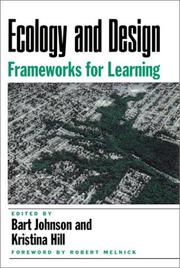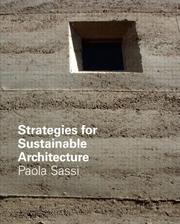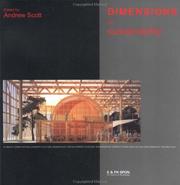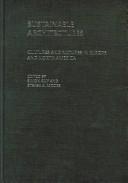| Listing 1 - 10 of 11 | << page >> |
Sort by
|

ISBN: 1597268658 1417595760 9781417595761 9781559638135 1559638133 9781597268653 Year: 2001 Publisher: Washington & Covelo & London : Island Press,
Abstract | Keywords | Export | Availability | Bookmark
 Loading...
Loading...Choose an application
- Reference Manager
- EndNote
- RefWorks (Direct export to RefWorks)
Ecology and Design: Frameworks for Learning explains why design professors (primarlly in the landscape architecture field) should teach ecology as a standard part of their courses and provides exampies from professors who already teach ecology and design in this way. More academics are beginning to understand the need to teach students about ecology in the design fields, but materials to facillitate that teaching are lacking. Some professors give up due to lack of support from academic institution, resistance from students, and/or lack of materials. Although academics are beginning to see the importance of this approach, there are few books available on this subject. In addition, the contributors are some of the most respected and well-recognised names in the field.
Ecological landscape design. --- Ecologically sound landscape design --- Environmentally sound landscape design --- Applied ecology --- Landscape design --- 711.1 --- 574 --- 712 --- Ontwerp (stedenbouw) --- Ecologie en bioverscheidenheid --- Landschapsarchitectuur

ISBN: 0415341426 9780415341424 9780203480106 9781134295326 9781134295364 9781134295371 9781138132290 Year: 2006 Publisher: London ; New York : Taylor & Francis,
Abstract | Keywords | Export | Availability | Bookmark
 Loading...
Loading...Choose an application
- Reference Manager
- EndNote
- RefWorks (Direct export to RefWorks)
Filling a gap in existing literature on sustainable design, this new guide introduces and illustrates sustainable design principles through detailed case studies of sustainable buildings in Europe, North America and Australia. The guide will provide the reader with a deeper understanding of the design issues involved in delivering sustainable buildings, and giving detailed description of the process of integrating principles into practice. One hundred buildings, ranging from small dwellings to large commercial buildings, and drawn from a range of countries, demonstrate best current practice. The sections of the book are divided into design issues relating to sustainable development, including site and ecology, community and culture, health, materials, energy, and water. With over 400 illustrations, this highly visual guide will be an invaluable reference to all those concerned with architecture and sustainability issues.
Sustainable architecture. --- Architecture durable --- 504 --- Eco-architecture --- Environmentally conscious architecture --- Environmentally friendly architecture --- Green architecture --- Green building design --- Green design (Buildings) --- Sustainable design (Buildings) --- Architecture --- Sustainable design --- Duurzame architectuur --- Duurzame ontwikkeling --- Duurzaamheid --- Duurzaam bouwen --- Ecologisch bouwen --- Ecologie --- Sustainable architecture --- Architecture écologique --- Matériau --- Eau --- Santé --- Energie --- Amérique du Nord --- Europe --- Australie --- 574 --- 69 --- 699 --- 699.86 --- Ecologie en bioverscheidenheid --- Bouwtechniek --- Bouwfysica --- Klimaatontwerp

ISBN: 0419236201 Year: 1998 Publisher: London E & FN Spon
Abstract | Keywords | Export | Availability | Bookmark
 Loading...
Loading...Choose an application
- Reference Manager
- EndNote
- RefWorks (Direct export to RefWorks)
This illustrated book gives a comprehensive view of _ contemporary ideas, innovations and emerging attitudes to sustainability that emanated from the MIT symposium. 16 leading contributors with demonstrable track records in architectural practice, engineering and academia give their insights into the way we need to think about architecture in the future in order to work with the environment - instead of against it. Supported by details that relate to specific design or research projects, they clearly suggest a variety of potential directions fo follow to bring environmentalism into the mainstream of architectural discourse. The edited summary of twelve key presentations at an International Design Symposium held at MIT. This book presents an important collection of contributions from key designers with a track record in the field of environmentally conscious buildings. Their contributions respond to a need for a more holistic view on environmentalism, focusing on cultural and social levels as well as technical issues to broaden the debate on sustainable architecture. This book will appeal to a wide range of professionals in the built environment, increasingly concerned with sustainable design.
sustainable development --- sustainable architecture --- Architecture --- 504 --- 72.025 --- 69 --- 72.012/013 --- Duurzame architectuur --- Natuurtechnische milieubouw ; alternatieve energiebronnen --- Architectuur ; milieuaspecten ; energiebesparing --- Ecologisch bouwen --- MIT ; Massachusetts Institute of Technology --- 72:574 --- 72.038 --- Duurzaamheid --- Herbestemming (architectuur) --- Herbruik (architectuur) --- Duurzame ontwikkeling --- Milieukunde --- Ecologie --- Bouwtechniek --- Bouwwezen --- Architectuurontwerp --- Architectuur en ecologie --- Architectuurgeschiedenis ; 1950 - 2000 --- Architecture, Modern --- Environmental aspects --- Technological innovations --- History --- 72.01 --- 72.03 --- 699 --- 699.86 --- 574 --- Architectuur (theorie) --- Architectuur (geschiedenis) --- Bouwfysica --- Klimaatontwerp --- Ecologie en bioverscheidenheid --- Architectuurtheorie

ISBN: 0415700450 0415700442 020341280X 9780415700443 9780415700450 0203693493 1280107464 1135995427 9780203412800 9786610107469 6610107467 9781135995423 9781135995379 1135995370 9781135995416 1135995419 9781280107467 Year: 2005 Publisher: New York Spon Press
Abstract | Keywords | Export | Availability | Bookmark
 Loading...
Loading...Choose an application
- Reference Manager
- EndNote
- RefWorks (Direct export to RefWorks)
As buildings are responsible for fifty per cent of CO2 emissions, their design has become the focus of intense technical scrutiny. Knowing how to build more technically efficient, or ecologically responsible, buildings, and being able to assemble the social resources to do so, requires different forms of knowledge and practice. There is wide contestation over the optimal pathways to greener buildings design and great diversity in practices of sustainable architecture. This volume brings together leading researchers from across the European Union and North America both to illustrate the diversity of practice and to provide a critical commentary on this key debate. The reader is provided with an introduction to competing perspectives on the sustainable architecture debate, international exemplars of differing practice and an overview of new theoretical and methodological resources for understanding and meeting the conceptual, social and technical challenges of sustainable architecture.
Sustainable architecture. --- Architecture --- Sustainable architecture --- Architecture durable --- Environmental aspects. --- Aspect de l'environnement --- 504 --- Architecture, Western (Western countries) --- Building design --- Buildings --- Construction --- Western architecture (Western countries) --- Art --- Building --- Eco-architecture --- Environmentally conscious architecture --- Environmentally friendly architecture --- Green architecture --- Green building design --- Green design (Buildings) --- Sustainable design (Buildings) --- Sustainable design --- Duurzaam bouwen --- Duurzame architectuur --- Duurzame ontwikkeling --- Ecologie --- Ecologisch bouwen --- Design and construction --- Art, Architecture & Applied Arts --- Environmental aspects --- 72.01 --- 711.4 --- Europa --- Noord-Amerika --- 574 --- 699.86 --- Architectuur (theorie) --- Stedenbouw (theorie) --- Ecologie en bioverscheidenheid --- Klimaatontwerp --- Architectuurtheorie --- Architecture, Primitive
Book
ISBN: 9783034608008 3034608004 3034611757 9783034611756 Year: 2012 Publisher: Basel
Abstract | Keywords | Export | Availability | Bookmark
 Loading...
Loading...Choose an application
- Reference Manager
- EndNote
- RefWorks (Direct export to RefWorks)
The goal of advancing eco cities often remains confined to political or technological issues. This book establishes a focus on architectural and infrastructural design approaches to sustainable urban planning. Starting out from a critical assessment of five prototypical eco cities of recent decades (Vauban/Germany, solarCity/Austria, Valdespartera and Sarriguren/Spain, Bo01/Sweden), the book identifies fields in which architectural and urban designers can use their creative skills and methods to achieve sustainable results on an urban scale. Sustainability is undergoing a shift of focus from quantitative measures toward designoriented, interactive interventions. The range of qualitative solutions in ecological design is discussed here in four topical sections on "Materialize", "Mobilize", "Simulate" and "Transform". For example, "Materialize" explores the potential of eco-design beyond the traditional palette of materials to show how spatial boundaries can be re-imagined as gradients of conditioned versus unconditioned space, working with climatic conditions rather than material boundaries to help generate new forms of urban architecture. Contributions by experts in the fields of architecture, landscape architecture, engineering and design theory, among them Achim Menges of Stuttgart University Institute for Computational Design, Federico Parolotto of Mobility in Chain, Edoardo Rico of Groundlab London, Sheila Kennedy of Massachusetts Institute of Technology and Matthias Sauerbruch of Sauerbruch Hutton, provide in-depth information on the complexity of eco-design in urban environments and emphasize the need for new sensibilities in disciplinary and trans-disciplinary thinking processes.
Sustainable architecture --- Urban ecology (Sociology) --- Ecological houses --- Building materials --- City planning --- Sustainability. --- Architecture, Modern --- Architecture --- Sustainability science --- Human ecology --- Social ecology --- Alternative homes --- Ecohomes --- Environmental homes --- Green homes (Green technology) --- Low impact houses --- Sustainable houses --- Dwellings --- Sustainable buildings --- Cities and towns --- Urban ecology --- Urban environment --- Sociology, Urban --- Eco-architecture --- Environmentally conscious architecture --- Environmentally friendly architecture --- Green architecture --- Green building design --- Green design (Buildings) --- Sustainable design (Buildings) --- Sustainable design --- Environmental aspects. --- History --- Environmental aspects --- Sustainability --- 711.4 --- 69.03 --- 699.86 --- 574 --- 504.75 --- 504.75 Human ecology and human environment --- Human ecology and human environment --- 711.4 Gemeentelijke planologie. Stadsplanning. Stedenbouw --- Gemeentelijke planologie. Stadsplanning. Stedenbouw --- Stedenbouw (theorie) --- Energie-efficiënte architectuur --- Klimaatontwerp --- Klimaatbeheersing --- Ecologie en bioverscheidenheid --- Architecture durable --- Ecologie urbaine --- Maisons écologiques --- Construction --- Urbanisme --- Durabilité de l'environnement --- Designs and plans. --- Dessins et plans --- Matériaux --- Aspect de l'environnement --- Sustainable urban development --- Sustainable development
Book
ISBN: 9783037781890 3037781890 Year: 2013 Publisher: Zurich Lars Müller
Abstract | Keywords | Export | Availability | Bookmark
 Loading...
Loading...Choose an application
- Reference Manager
- EndNote
- RefWorks (Direct export to RefWorks)
While climate change, sustainable architecture, and green technologies have become increasingly topical, issues surrounding the sustainability of the city are much less developed.The premise of the book 'Ecological Urbanism' is that an ecological approach is urgently needed both as a remedial device for the contemporary city and an organizing principle for new cities. “Ecological Urbanism” approaches the city without any one set of instruments and with a worldview that is fluid in scale and disciplinary approach. Design provides the synthetic key to connect ecology with an urbanism that is not in contradiction with its environment.The book 'Ecological Urbanism' brings together design practitioners and theorists, economists, engineers, artists, policy makers, environmental scientists, and public health specialists, with the goal of reaching a more robust understanding of ecological urbanism and what it might be in the future.With contributions by Homi Bhabha, Stefano Boeri, Chuck Hoberman, Rem Koolhaas, Sanford Kwinter, Bruno Latour, Nina-Marie Lister, Mohsen Mostafavi, Matthias Schuler, Sissel Tolaas, Charles Waldheim, among others.
Environmental planning --- Environmental protection. Environmental technology --- Population urbaine --- Urban population --- 72:574(035) --- Duurzame stedenbouw --- Ecologie ; stedenbouw --- Stedenbouw. Ruimtelijke ordening ; vormgeving en analyse van de stad --- Architectuur en ecologie ; handboeken --- Dégradation --- 711.4(C) --- Ecologische stedenbouw --- 711.4 --- 911.375 --- 504.54 --- 504 --- Urbanisatie (stedelijke omgeving, verstedelijking) --- 504.54 Landscape. Landscape ecology --- Landscape. Landscape ecology --- 711.4 Gemeentelijke planologie. Stadsplanning. Stedenbouw --- Gemeentelijke planologie. Stadsplanning. Stedenbouw --- Urban settlements (their study and geography). Towns. Cities --- Ecologie --- Duurzaamheid --- Duurzame ontwikkeling --- Urbanisme durable --- Ecologie appliquée --- Urbanization --- Environmental aspects. --- ecology --- urbanism --- urban planning --- urban development --- Urban environment --- amenity planting --- world --- Sustainable urban development --- Urban ecology (Sociology) --- City planning. --- Environmental degradation. --- Sustainable development. --- Ecologie urbaine --- Urbanisme --- Environnement --- Développement durable --- 712 --- 574 --- Stedenbouw (theorie) --- Landschapsarchitectuur --- Ecologie en bioverscheidenheid
Book
ISBN: 9780810997028 0810997029 9781613122860 1613122861 1613122861 Year: 2012 Publisher: New York, N.Y. Abrams
Abstract | Keywords | Export | Availability | Bookmark
 Loading...
Loading...Choose an application
- Reference Manager
- EndNote
- RefWorks (Direct export to RefWorks)
Design Like You Give a Damn [2] is the indispensable handbook for anyone committed to building a more sustainable future. Following the success of their first book, Architecture for Humanity brings readers the next edition, with more than 100 projects from around the world. Packed with practical and ingenious design solutions, this book addresses the need for basic shelter, housing, education, health care, clean water, and renewable energy. One-on-one interviews and provocative case studies demonstrate how innovative design is reimagining community and uplifting lives. From building-material innovations such as smog-eating concrete to innovative public policy that is repainting Brazil’s urban slums, Design Like You Give a Damn [2] serves as a how-to guide for anyone seeking to build change from the ground up. Praise for Design Like You Give a Damn [2]: “The resourcefulness of the projects in the book is inspiring, its information practical (see Stohr’s chapter on financing sustainable community development) and its numerous factoids sobering.” - TMagazine.blogs.NYTimes.com
Emergency housing --- Buildings, Temporary --- Disaster victims --- Architecture and society. --- Logement de secours --- Constructions provisoires --- Victimes de catastrophes --- Architecture et société --- Design and construction. --- Design and construction --- Dwellings --- Conception et construction --- Habitations --- 504 --- 72.037 --- 721.7 --- Duurzame ontwikkeling --- Duurzaamheid --- Duurzame architectuur --- 21ste eeuw (architectuur) --- Eenentwintigste eeuw (architectuur) --- Vluchtelingenkampen --- Tijdelijke architectuur --- emergency housing --- temporary buildings --- sustainable architecture --- Architecture --- architecture [discipline] --- 574 --- 711.1 --- 711.4 --- Ecologie en bioverscheidenheid --- Ontwerp (stedenbouw) --- Stedenbouw (theorie) --- Sustainable architecture. --- Sustainable urban development. --- Sustainable buildings --- Buildings, Demountable --- Demountable buildings --- Temporary buildings --- Civil defense --- Disaster relief --- Housing --- Ecologically sustainable design (Buildings) --- Environmentally sustainable design (Buildings) --- ESD design (Buildings) --- Green building design --- Green design (Buildings) --- Sustainable design (Buildings) --- Environmentally sustainable urban development --- City planning --- Sustainable development --- Architecture and sociology --- Society and architecture --- Sociology and architecture --- Eco-architecture --- Environmentally conscious architecture --- Environmentally friendly architecture --- Green architecture --- Sustainable design --- Social aspects --- Human factors --- samenleving
Book
ISBN: 3035615314 9783035615319 3038215791 9783035615111 Year: 2020 Publisher: Basel Birkhäuser
Abstract | Keywords | Export | Availability | Bookmark
 Loading...
Loading...Choose an application
- Reference Manager
- EndNote
- RefWorks (Direct export to RefWorks)
The emergent understanding of the building and the city as ecological systems immediately raises the question of their interaction. In which ways does a "green building" contribute to the ecology of its surroundings? And how can ecologically designed urban districts, with their green and blue networks, link up with the elements and technologies of building design? These are questions of concept, of planning, of design and not least of experience. All these dimensions of "green building" are investigated in this book with substantial essays and benchmark case studies, in a collaboration of a research team with internationally renowned architects, urbanists and landscape designers - in an effort to understand and evaluate some of the most recent and innovative Dense+Green Cities in Asia, the Americas and Europe."
712.02 --- 71:574 --- Verticale tuinen --- Openbaar groen; stedelijke groene ruimten --- Gevelconstructies ; buitenmuren ; met planten --- Landschaps- en tuinarchitectuur ; aanleggen van parken, tuinen --- Stedenbouw en ecologie --- Groenvoorzieningen ; steden --- Duurzaam bouwen --- Architectuur --- 504 --- 72.037 --- Duurzame stedenbouw --- Milieu --- Ecologie --- Duurzaamheid --- Duurzame ontwikkeling --- Eenentwintigste eeuw (architectuur) --- 21ste eeuw (architectuur) --- 711.64 --- 574 --- 711.4 --- Densiteit --- Verdichting --- Ecologie en bioverscheidenheid --- Stedenbouw (theorie) --- Environmental planning --- Architecture --- population density --- urban development --- human ecology --- sustainable architecture --- Social geography --- Sustainable architecture --- Sustainable buildings --- Urban density --- City Planning --- Densité urbaine --- Planification urbaine --- Urbanisme durable --- Construction écologique --- Architecture écologique --- Densification --- Design and construction --- Environmental aspects --- Sustainable buildings - Design and construction --- Architecture - Environmental aspects --- Architecture durable --- Constructions durables --- Conception et construction --- Aspect de l'environnement
Book
ISBN: 9783035621099 3035621098 9783035626353 Year: 2022 Publisher: Basel Birkhäuser
Abstract | Keywords | Export | Availability | Bookmark
 Loading...
Loading...Choose an application
- Reference Manager
- EndNote
- RefWorks (Direct export to RefWorks)
"Circular Building and Circular Economy presents concepts, methods and examples of circularity in construction and the economy. Urban mining and circular construction are two approaches to the challenges that architecture and urban design are facing, using techniques such as mono-material construction and design for disassembly, and tools such as materials passports and databases. The circular economy is not solely about recycling but encompasses a wide range of strategies from local community projects to new ownership and service models and steering mechanisms such as carbon fees and dividends" [Publisher]
Hergebruik ; sloophout ; afvalmateriaal --- Architectuur ; design ; recupereerbare materialen --- Architectuur ; recyclage van materialen en bouwonderdelen --- Bouwconstructies ; bouwelementen ; recyclagematerialen --- Bouwmaterialen; afbraakmaterialen ; recyclagematerialen --- 72:574 --- Architectuur en ecologie ; architectuur en milieu --- Circular economy. --- Sustainable construction. --- BUILDING SUSTAINABILITY -- 72 --- 504 --- recyclage (bouwmateriaal) --- 574 --- Duurzaam bouwen --- Ecologie en bioverscheidenheid --- 691 --- Bouwmaterialen (architectuur) --- Architecture écologique --- Economie circulaire --- Développement durable --- Changement climatique --- Construction écologique --- 692 --- Constructie-elementen --- Circulair bouwen --- Circular economy --- Sustainable construction --- Architecture --- Building materials --- Économie circulaire --- Construction durable --- Construction --- Environmental aspects --- Recycling. --- Aspect de l'environnement --- Matériaux --- Recyclage --- Sustainable development. --- Climatic changes. --- Recycling (Waste, etc.) --- Économie circulaire. --- Construction durable. --- Changements climatiques. --- Recyclage (déchets, etc.) --- Civil engineering. Building industry --- circulaire economie --- duurzaamheid --- Économie circulaire. --- Recyclage (déchets, etc.) --- Relation between energy and economics --- Production management --- economics --- adaptive reuse --- recycling --- sustainable architecture --- sustainability
Book
ISBN: 9783642006357 9783642006340 Year: 2010 Publisher: Berlin, Heidelberg Springer Berlin Heidelberg
Abstract | Keywords | Export | Availability | Bookmark
 Loading...
Loading...Choose an application
- Reference Manager
- EndNote
- RefWorks (Direct export to RefWorks)
An important consideration for energy-efficient buildings is their primary energy requirements over the entire life cycle. How to determine this? What integrative factors influence the performance of a healthy and sustainable building? This, while it may be important for clients and architects to know, is frequently not very transparent.This book has been written to assist with clarifying target criteria and expanding horizons when it comes to ecological buildings. It is meant as a handbook and source of reference for clients, architects, planners and building operators, to provide them with pertinent information about their design, construction and operation: how to do this in the most energy-efficient and economical manner? Also, there is feedback and documentation about prominent buildings like the Hamburg Dockland or the Landesbank Baden-Wuerttemberg in Stuttgart. They provide excellent architectural examples for detailed construction and design solutions. Further, there are insightful interviews with architects and clients about many important buildings, which help turn this book into an integrated source of reference for sustainable architecture.- A Guideline for Planning, Construction and Operation of sustainable Buildings- A source of reference for clients, architects, planners and building operators- Innovative architectural examples with sustainable concepts and design
Engineering. --- Civil Engineering. --- Architecture, general. --- Energy Economics. --- Environment, general. --- Energy Technology. --- Energy Efficiency (incl. Buildings). --- Architecture. --- Civil engineering. --- Electric engineering. --- Engineering economy. --- Environmental sciences. --- Ingénierie --- Architecture --- Génie civil --- Décision économique, prise de --- Sciences de l'environnement --- Sustainable architecture. --- Architecture and energy conservation --- Buildings --- -72.039 --- 69.504 --- 620.9 --- 697.11 --- 699.86 --- 504 --- 69 --- 69.03 --- Drees & Sommer --- D&S Advanced Building Technologies --- Edifices --- Halls --- Structures --- Energy conservation and architecture --- Energy efficient buildings --- Energy conservation --- Eco-architecture --- Environmentally conscious architecture --- Environmentally friendly architecture --- Green architecture --- Green building design --- Green design (Buildings) --- Sustainable design (Buildings) --- Sustainable design --- Hedendaagse architectuur. Bouwkunst sinds 1960 --- Building and the environment. Sustainable building --- Economics of energy in general --- General principles. Properties of buildings from heating point of view (measurements, results). Temperature levels. Fuel consumption --- Thermal insulation of buildings. Cold-resistant and heat-resistant construction. Expansion joints --- Duurzaam bouwen --- Duurzame architectuur --- Duurzame ontwikkeling --- Ecologie --- Ecologisch bouwen --- Bouwtechniek --- Bouwwezen --- Energie-efficiënte architectuur --- Klimaatbeheersing --- 699.86 Thermal insulation of buildings. Cold-resistant and heat-resistant construction. Expansion joints --- 697.11 General principles. Properties of buildings from heating point of view (measurements, results). Temperature levels. Fuel consumption --- 620.9 Economics of energy in general --- 69.504 Building and the environment. Sustainable building --- 72.039 Hedendaagse architectuur. Bouwkunst sinds 1960 --- Sustainable architecture --- Sustainable buildings --- 72.039 --- Ecologically sustainable buildings --- Environmentally sustainable buildings --- Green buildings (Green technology) --- Sustainable development --- Design and construction --- 574 --- 699 --- Ecologie en bioverscheidenheid --- Bouwfysica --- Zero energy buildings
| Listing 1 - 10 of 11 | << page >> |
Sort by
|

 Search
Search Feedback
Feedback About UniCat
About UniCat  Help
Help News
News